Performance Enhancement of DWDM-FSO Optical Fiber Communication Systems Based on Hybrid Modulation Techniques under Atmospheric Turbulence Channel
Abstract
:1. Introduction
2. System Description
3. M-ary Digital Pulse Position Modulation and M-pulse Amplitude and Position Modulation (M-ary DPPM-M-PAPM) Scheme
4. Atmospheric Turbulence Channel
5. Results and Discussion
6. Conclusions
Author Contributions
Funding
Data Availability Statement
Conflicts of Interest
References
- Phillips, A.; Cryan, R.; Senior, J. An optically preamplified intersatellite PPM receiver employing maximum likelihood detection. IEEE Photon-Technol. Lett. 1996, 8, 691–693. [Google Scholar] [CrossRef]
- Aladeloba, A.; Phillips, A.; Woolfson, M. Performance evaluation of optically preamplified digital pulse position modulation turbulent free-space optical communication systems. IET Optoelectron. 2012, 6, 66–74. [Google Scholar] [CrossRef]
- Ohtsuki, T. Performance analysis of indoor infrared wireless systems using PPM CDMA. Electron. Commun. Jpn. Part I Commun. 2002, 85, 1–10. [Google Scholar] [CrossRef]
- Leeson, M. Pulse position modulation for spectrum-sliced transmission. IEEE Photon-Technol. Lett. 2004, 16, 1191–1193. [Google Scholar] [CrossRef]
- Mbah, A.M.; Walker, J.G.; Phillips, A.J. Performance evaluation of turbulence-accentuated interchannel crosstalk for hybrid fibre and free-space optical wavelength-division-multiplexing systems using digital pulse-position modulation. IET Optoelectron. 2016, 10, 11–20. [Google Scholar] [CrossRef] [Green Version]
- Garrett, I. Pulse-position modulation for transmission over optical fibers with direct or heterodyne detection. IEEE Trans. Commun. 1983, 31, 518–527. [Google Scholar] [CrossRef]
- Phillips, A.; Cryan, R.; Senior, J. Optically preamplified pulse-position modulation for fibre-optic communication systems. IEE Proc.-Optoelectron. 1996, 143, 153–159. [Google Scholar] [CrossRef]
- Elsayed, E.E.; Yousif, B.B.; Alzalabani, M.M. Performance enhancement of the power penalty in DWDM FSO communication using DPPM and OOK modulation. Opt. Quantum Electron. 2018, 50, 282. [Google Scholar] [CrossRef]
- Elsayed, E.E.; Yousif, B.B. Performance enhancement of M-ary pulse-position modulation for a wavelength division multiplexing free-space optical systems impaired by interchannel crosstalk, pointing error, and ASE noise. Opt. Commun. 2020, 475, 126219. [Google Scholar] [CrossRef]
- Elsayed, E.E.; Yousif, B.B. Performance enhancement of the average spectral efficiency using an aperture averaging and spatial-coherence diversity based on the modified-PPM modulation for MISO FSO links. Opt. Commun. 2020, 463, 125463. [Google Scholar] [CrossRef]
- De Andrade, M.; Kramer, G.; Wosinska, L.; Chen, J.; Sallent, S.; Mukherjee, B. Evaluating strategies for evolution of passive optical networks. IEEE Commun. Mag. 2011, 49, 176–184. [Google Scholar] [CrossRef]
- Kramer, G.; Pesavento, G. Ethernet passive optical network (EPON): Building a next-generation optical access network. IEEE Commun. Mag. 2002, 40, 66–73. [Google Scholar] [CrossRef] [Green Version]
- Kim, B.; Kim, B.-W. WDM-PON development and deployment as a present optical access solution. In Proceedings of the Optical Fiber Communication Conference, San Diego, CA, USA, 22–26 March 2009. [Google Scholar]
- Wang, K.; Nirmalathas, A.; Lim, C.; Skafidas, E. 4 × 12.5 Gb/s WDM optical wireless communication system for indoor applications. J. Light. Technol. 2011, 29, 1988–1996. [Google Scholar] [CrossRef]
- Aladeloba, A.O.; Woolfson, M.S.; Phillips, A.J. WDM FSO network with turbulence-accentuated interchannel crosstalk. J. Opt. Commun. Netw. 2013, 5, 641–651. [Google Scholar] [CrossRef]
- Chang, G.-K.; Chowdhury, A.; Jia, Z.; Chien, H.-C.; Huang, M.-F.; Yu, J.; Ellinas, G. Key technologies of WDM-PON for future converged optical broadband access networks. J. Opt. Commun. Netw. 2009, 1, C35–C50. [Google Scholar] [CrossRef]
- Available online: http://eprints.nottingham.ac.uk/13304/1/AladelobaAbisayoThesis.pdf (accessed on 10 October 2021).
- Ciaramella, E.; Arimoto, Y.; Contestabile, G.; Presi, M.; D’Errico, A.; Guarino, V.; Matsumoto, M. 1.28 terabit/s (32 × 40 Gbit/s) WDM transmission system for free space optical communications. IEEE J. Sel. Areas Commun. 2009, 27, 1639–1645. [Google Scholar] [CrossRef]
- Forbes, M.; Gourlay, J.; Desmulliez, M. Optically interconnected electronic chips: A tutorial and review of the technology. Electron. Commun. Eng. J. 2001, 13, 221–232. [Google Scholar] [CrossRef]
- Ansari, N.; Zhang, J. Media Access Control and Resource Allocation: For Next Generation Passive Optical Networks; Springer Science & Business Media: Berlin/Heidelberg, Germany, 2013. [Google Scholar]
- Zuo, T.; Phillips, A. Performance of burst-mode receivers for optical digital pulse position modulation in passive optical network application. IET Optoelectron. 2009, 3, 123–130. [Google Scholar] [CrossRef]
- Yousif, B.B.; Elsayed, E.E. Performance enhancement of an orbital-angular-momentum-multiplexed free-space optical link under atmospheric turbulence effects using spatial-mode multiplexing and hybrid diversity based on adaptive MIMO equalization. IEEE Access 2019, 7, 84401–84412. [Google Scholar] [CrossRef]
- Yamamoto, Y. Noise and error rate performance of semiconductor laser amplifiers in PCM-IM optical transmission systems. IEEE J. Quantum Electron. 1980, 16, 1073–1081. [Google Scholar] [CrossRef]
- Ribeiro, L.; da Rocha, J.; Pinto, O.; da Rocha, J.F.; Pinto, J. Performance evaluation of EDFA preamplified receivers taking into account intersymbol interference. J. Light. Technol. 1995, 13, 225–232. [Google Scholar] [CrossRef]
- O’Reilly, J.; da Rocha, J.F. Improved error probability evaluation methods for direct detection optical communication systems. IEEE Trans. Inf. Theory 1987, 33, 839–848. [Google Scholar] [CrossRef]
- Al-Orainy, A.; O’Reilly, J. Error probability bounds and approximations for the influence of crosstalk on wavelength division multiplexed systems. IEE Proc. J Optoelectron. 1990, 137, 379–384. [Google Scholar] [CrossRef]
- Personick, S.D. Applications for quantum amplifiers in simple digital optical communication systems. Bell Syst. Tech. J. 1973, 52, 117–133. [Google Scholar] [CrossRef]
- Ma, R.; Zuo, T.; Phillips, A.; Sujecki, S. Improved performance evaluation for DC-coupled burst mode reception in the presence of amplified spontaneous emission noise and interchannel crosstalk. IET Optoelectron. 2010, 4, 121–132. [Google Scholar] [CrossRef]
- Elsayed, E.E.; Yousif, B.B. Performance enhancement of hybrid diversity for M-ary modified pulse-position modulation and spatial modulation of MIMO-FSO systems under the atmospheric turbulence effects with geometric spreading. Opt. Quantum Electron. 2020, 52, 1–18. [Google Scholar] [CrossRef]
- Andrews, L.C.; Phillips, R.L.; Young, C.Y. Laser Beam Scintillation with Applications; SPIE: Bellingham, WA, USA, 2001. [Google Scholar] [CrossRef] [Green Version]
- Trinh, P.V.; Dang, N.T.; Thang, T.C.; Pham, A. Performance of all-optical amplify-and-forward WDM/FSO relaying systems over atmospheric dispersive turbulence channels. IEICE Trans. Commun. 2016, 99, 1255–1264. [Google Scholar] [CrossRef] [Green Version]
- Majumdar, A.K. Free-space laser communication performance in the atmospheric channel. J. Opt. Fiber Commun. Rep. 2005, 2, 345–396. [Google Scholar] [CrossRef]
- Khalighi, M.; Schwartz, N.; Aitamer, N.; Bourennane, S. Fading reduction by aperture averaging and spatial diversity in optical wireless systems. J. Opt. Commun. Netw. 2009, 1, 580–593. [Google Scholar] [CrossRef]
- Al-Habash, M.A. Mathematical model for the irradiance probability density function of a laser beam propagating through turbulent media. Opt. Eng. 2001, 40, 1554. [Google Scholar] [CrossRef]
- Popoola, W.O.; Ghassemlooy, Z. BPSK subcarrier intensity modulated free-space optical communications in atmospheric turbulence. J. Light. Technol. 2009, 27, 967–973. [Google Scholar] [CrossRef]
- Rajiv Ramaswami, K.N.S. Optical Networks a Practical Perspective. 2010. Available online: http://www.cesarkallas.net/arquivos/faculdade-pos/TP319-redes-opticas/Optical-Networks-3nd.pdf (accessed on 10 October 2021).
- Maru, K.; Mizumoto, T.; Uetsuka, H. Demonstration of flat-passband multi/demultiplexer using multi-input arrayed waveguide grating combined with cascaded mach–zehnder interferometers. J. Light. Technol. 2007, 25, 2187–2197. [Google Scholar] [CrossRef]
- Hirano, A.; Miyamoto, Y.; Kuwahara, S. Performances of CSRZ-DPSK and RZ-DPSK in 43-Gbit/s/ch DWDM G.652 single-mode-fiber transmission. J. Lightwave Technol. 2003, 86, 454–456. [Google Scholar] [CrossRef]
- Yu, C.X.; Neilson, D.T. Diffraction-grating-based (de)multiplexer using image plane transformations. IEEE J. Sel. Top. Quantum Electron. 2002, 8, 1194–1201. [Google Scholar] [CrossRef]
- Henry, P.S. Error-rate performance of optical amplifiers. In Proceedings of the Optical Fiber Communication Conference, Houston, TX, USA, 6 February 1989. [Google Scholar]
- Elsayed, E.E.; Yousif, B.B. Performance evaluation and enhancement of the modified OOK based IM/DD techniques for hybrid fiber/FSO communication over WDM-PON systems. Opt. Quantum Electron. 2020, 52, 1–27. [Google Scholar] [CrossRef]
- Mbah, A.M.; Walker, J.G.; Phillips, A.J. Performance evaluation of digital pulse position modulation for wavelength division multiplexing FSO systems impaired by interchannel crosstalk. IET Optoelectron. 2014, 8, 245–255. [Google Scholar] [CrossRef] [Green Version]
- Yousif, B.B.; Elsayed, E.E.; Alzalabani, M.M. Atmospheric turbulence mitigation using spatial mode multiplexing and modified pulse position modulation in hybrid RF/FSO orbital-angular-momentum multiplexed based on MIMO wireless communications system. Opt. Commun. 2019, 436, 197–208. [Google Scholar] [CrossRef]
- Mbah, A.M.; Walker, J.G.; Phillips, A.J. Outage probability of WDM free-space optical systems affected by turbulence-accentuated interchannel crosstalk. IET Optoelectron. 2017, 11, 91–97. [Google Scholar] [CrossRef]
- Aladeloba, A.; Phillips, A.; Woolfson, M. Improved bit error rate evaluation for optically pre-amplified free-space optical communication systems in turbulent atmosphere. IET Optoelectron. 2012, 6, 26–33. [Google Scholar] [CrossRef]
- Aladeloba, A.O.; Phillips, A.J.; Woolfson, M.S. DPPM FSO communication systems impaired by turbulence, pointing error and ASE noise. In Proceedings of the 14th International Conference on Transparent Optical Networks (ICTON), Coventry, UK, 2–5 July 2012; pp. 1–4. [Google Scholar] [CrossRef]
- Mukherjee, B. WDM optical communication networks: Progress and challenges. IEEE J. Sel. Areas Commun. 2000, 18, 1810–1824. [Google Scholar] [CrossRef]
- Mallick, K.; Mandal, P.; Mandal, G.C.; Mukherjee, R.; Das, B.; Patra, A.S. Hybrid MMW-over fiber/OFDM-FSO transmission system based on doublet lens scheme and POLMUX technique. Opt. Fiber Technol. 2019, 52, 101942. [Google Scholar] [CrossRef]
- Mallick, K.; Mandal, P.; Mukherjee, R.; Mandal, G.C.; Das, B.; Patra, A.S. Generation of 40 GHz/80 GHz OFDM based MMW source and the OFDM-FSO transport system based on special fine tracking technology. Opt. Fiber Technol. 2020, 54, 102130. [Google Scholar] [CrossRef]
- Idris, S.; Selmy, H.; Lopes, W.T.A. Performance analysis of hybrid MPAPM technique for deep-space optical communications. IET Commun. 2021, 15, 1700–1709. [Google Scholar] [CrossRef]
- Magidi, S.; Jabeena, A. Analysis of multi-pulse position modulation free space optical communication system employing wavelength and time diversity over Malaga turbulence channel. Sci. Afr. 2021, 12, e00777. [Google Scholar] [CrossRef]
- Alipour, A.; Farmani, A.; Mir, A. Analysis of optical power budget in DWDM-FSO link under outdoor atmospheric channel model. Opt. Quantum Electron. 2021, 53, 1–15. [Google Scholar] [CrossRef]
- Ran, H.; Zhang, J.; Pan, G.; Xie, Y. Outage probability of wireless-powered multi-relaying MIMO FSO-RF systems. Opt. Commun. 2021, 498, 127260. [Google Scholar] [CrossRef]
- Zhang, T.; Wang, P.; Liu, T.; Jia, C.; Pang, W.-N.; Wang, W. Performance analysis of multi-hop parallel FSO system over double generalized gamma distribution considering two transmission beams. Optoelectron. Lett. 2021, 17, 215–220. [Google Scholar] [CrossRef]
- Willner, A.E.; Zhao, Z.; Liu, C.; Zhang, R.; Song, H.; Pang, K.; Manukyan, K.; Song, H.; Su, X.; Xie, G.; et al. Perspectives on advances in high-capacity, free-space communications using multiplexing of orbital-angular-momentum beams. APL Photonics 2021, 6, 030901. [Google Scholar] [CrossRef]
- Sharma, K.; Grewal, S.K. Performance assessment of hybrid PPM–BPSK–SIM based FSO communication system using time and wavelength diversity under variant atmospheric turbulence. Opt. Quantum Electron. 2020, 52, 1–25. [Google Scholar] [CrossRef]
- Singh, M.; Malhotra, J. Performance comparison of M-QAM and DQPSK modulation schemes in a 2 × 20 Gbit/s–40 GHz hybrid MDM–OFDM-based radio over FSO transmission system. Photon.-Netw. Commun. 2019, 38, 378–389. [Google Scholar] [CrossRef]
- Malik, S.; Sahu, P.K. Performance analysis of free space optical communication system using different modulation schemes over weak to strong atmospheric turbulence channels. Lect. Notes Electr. Eng. 2019, 546, 387–399. [Google Scholar] [CrossRef]
- Srivastava, V.; Mandloi, A.; Soni, G.G. Outage probability and average BER estimation of FSO system employing wavelength diversity. Opt. Quantum Electron. 2019, 51, 229. [Google Scholar] [CrossRef]
- Mukherjee, R.; Mallick, K.; Kuiri, B.; Santra, S.; Dutta, B.; Mandal, P.; Patra, A.S. PAM-4 based long-range free-space-optics communication system with self injection locked QD-LD and RS codec. Opt. Commun. 2020, 476, 126304. [Google Scholar] [CrossRef]
- Mukherjee, R.; Mallick, K.; Mandal, P.; Dutta, B.; Kuiri, B.; Patra, A.S. Bidirectional hybrid OFDM based free-space/wireless-over-fiber transport system. Opt. Quantum Electron. 2020, 52, 1–12. [Google Scholar] [CrossRef]
- Saxena, P.; Mathur, A.; Bhatnagar, M.R. BER performance of an optically pre-amplified FSO system under turbulence and pointing errors with ASE noise. J. Opt. Commun. Netw. 2017, 9, 498–510. [Google Scholar] [CrossRef]


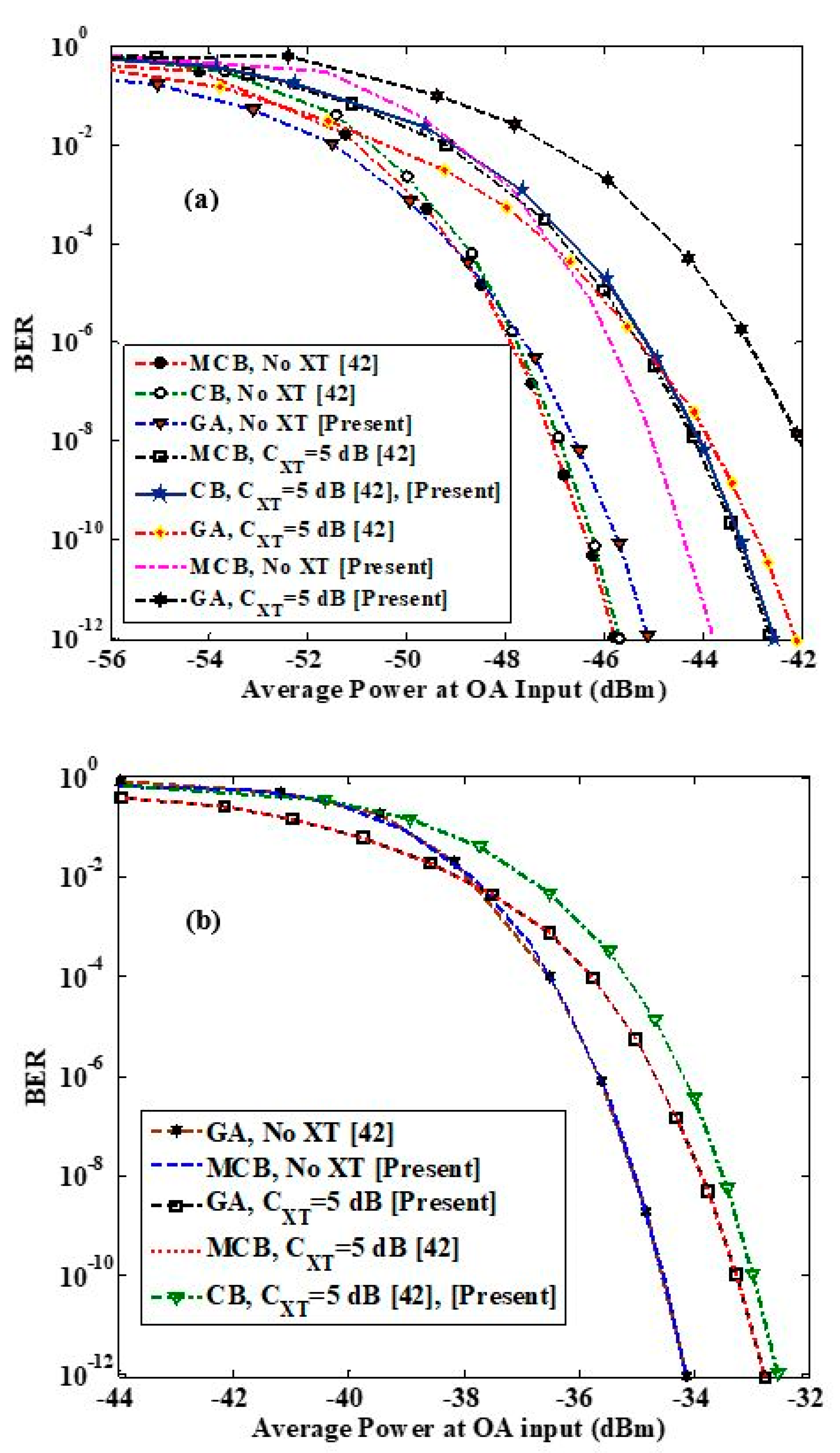

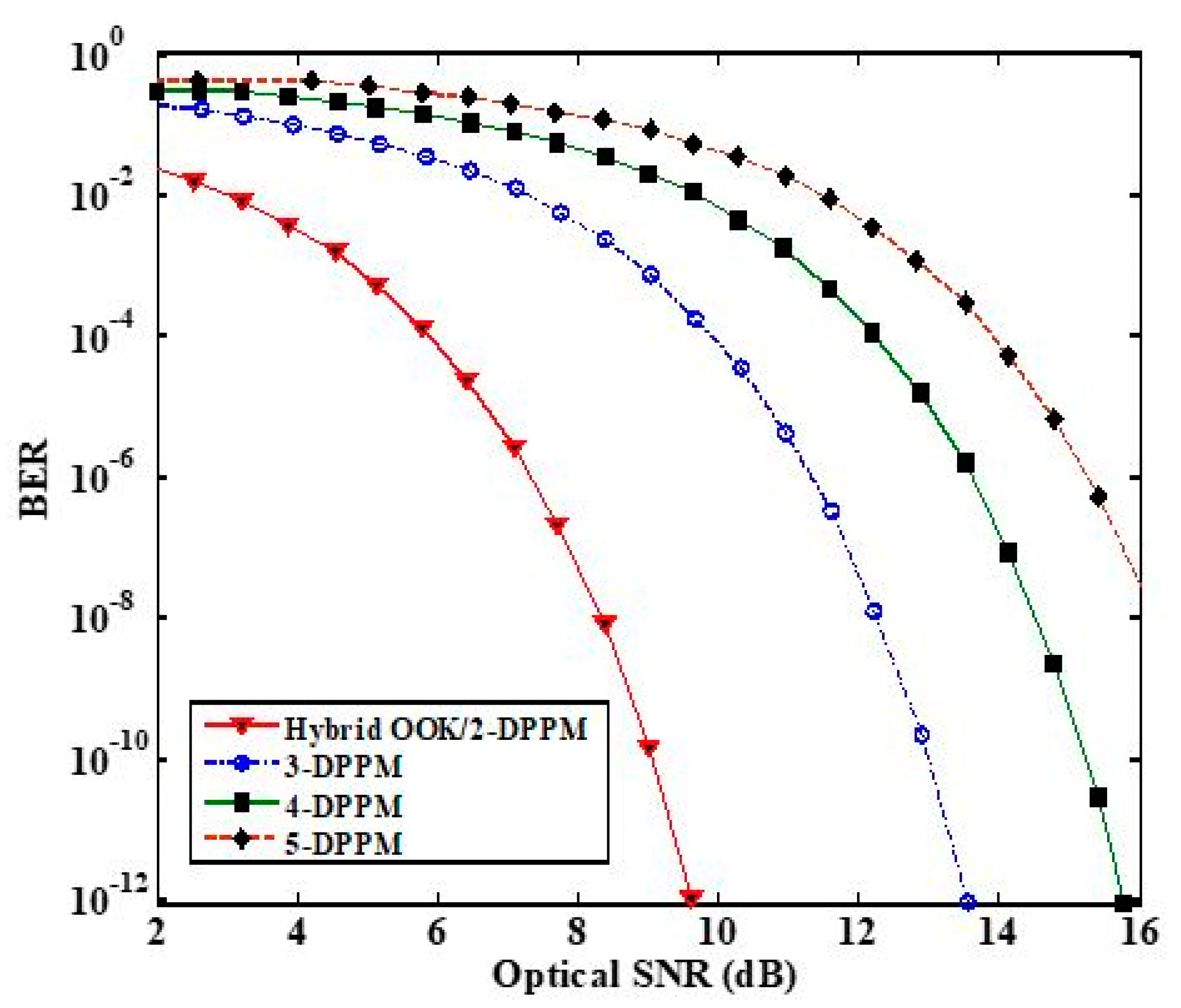
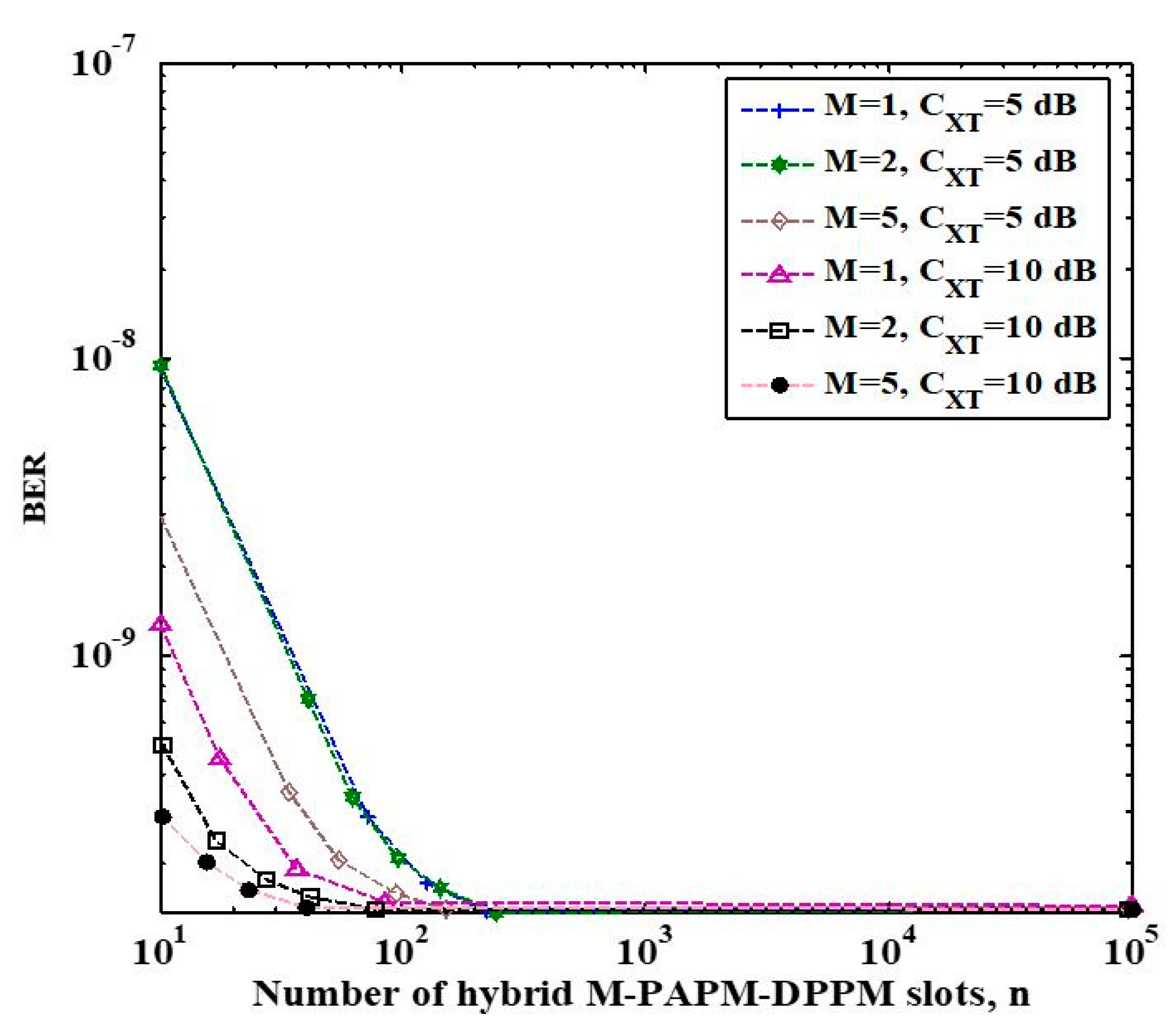
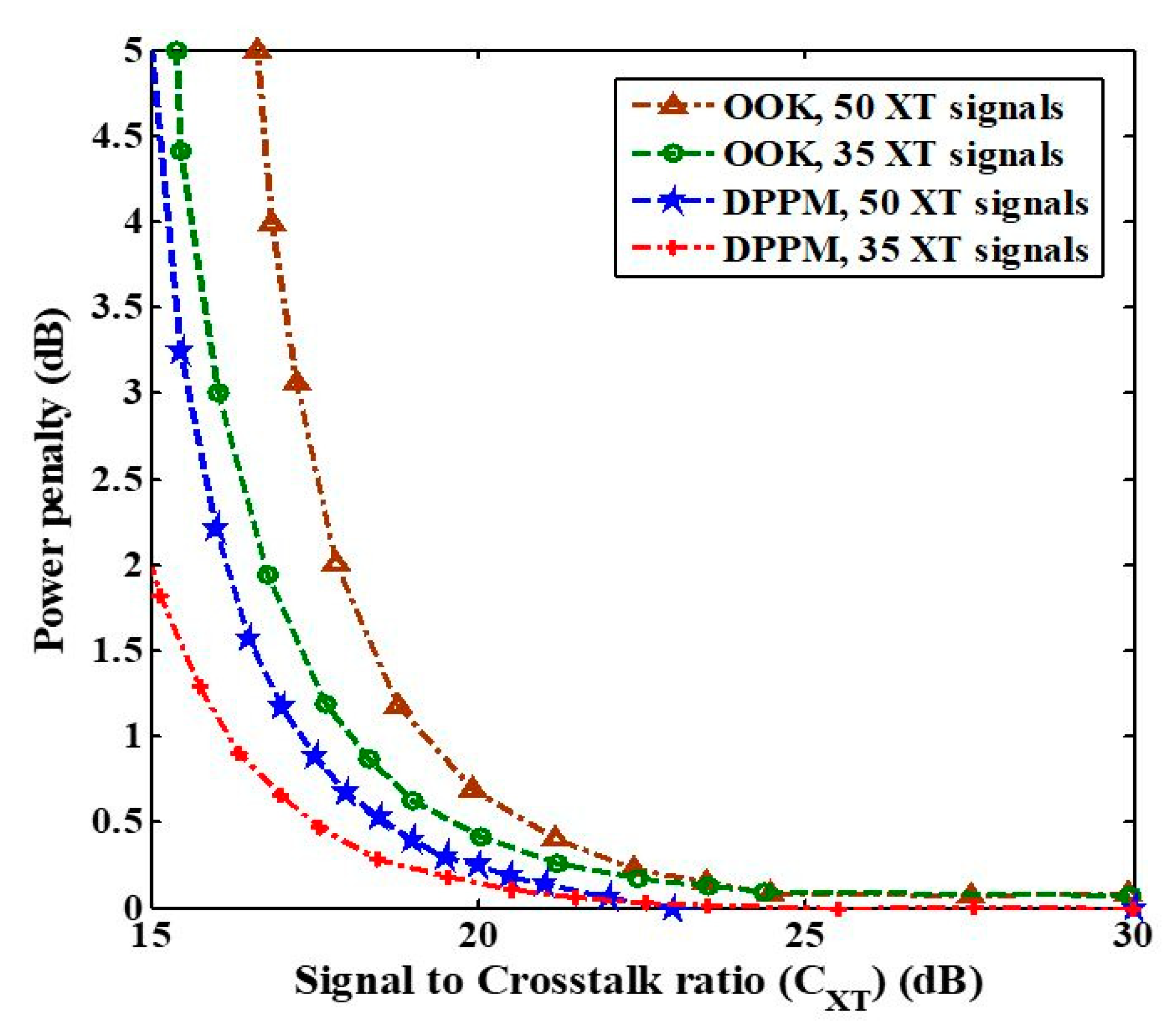

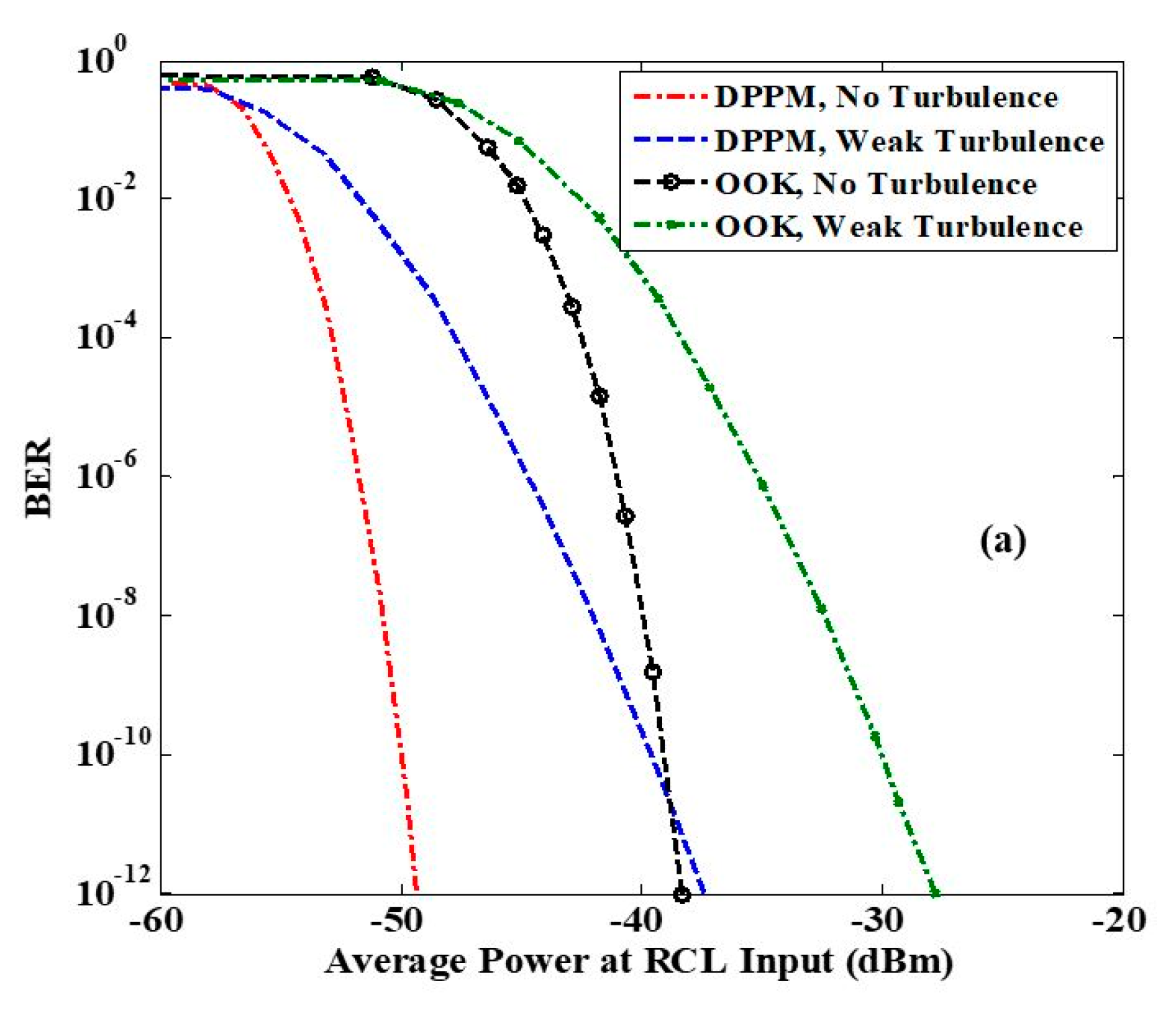
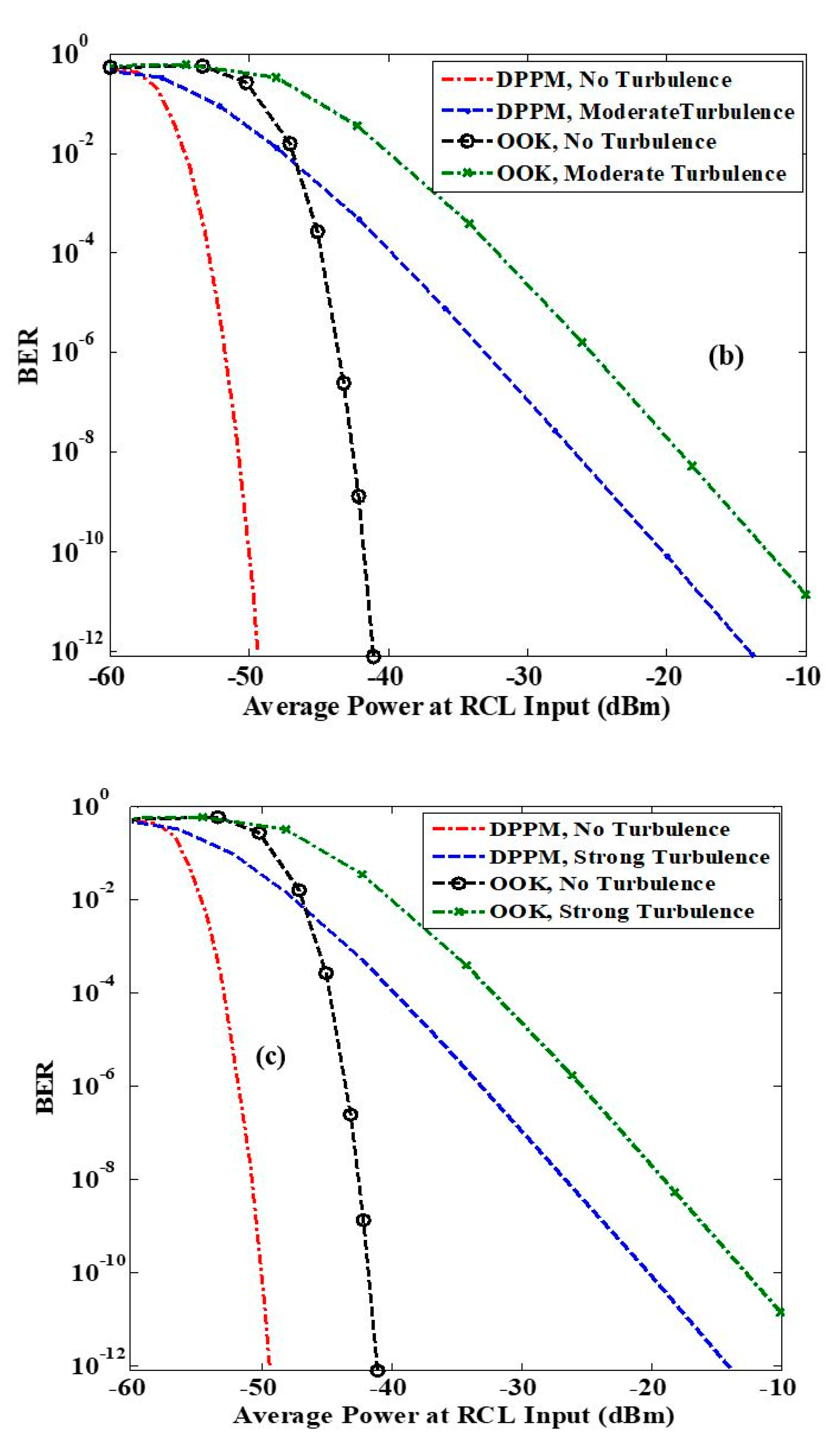
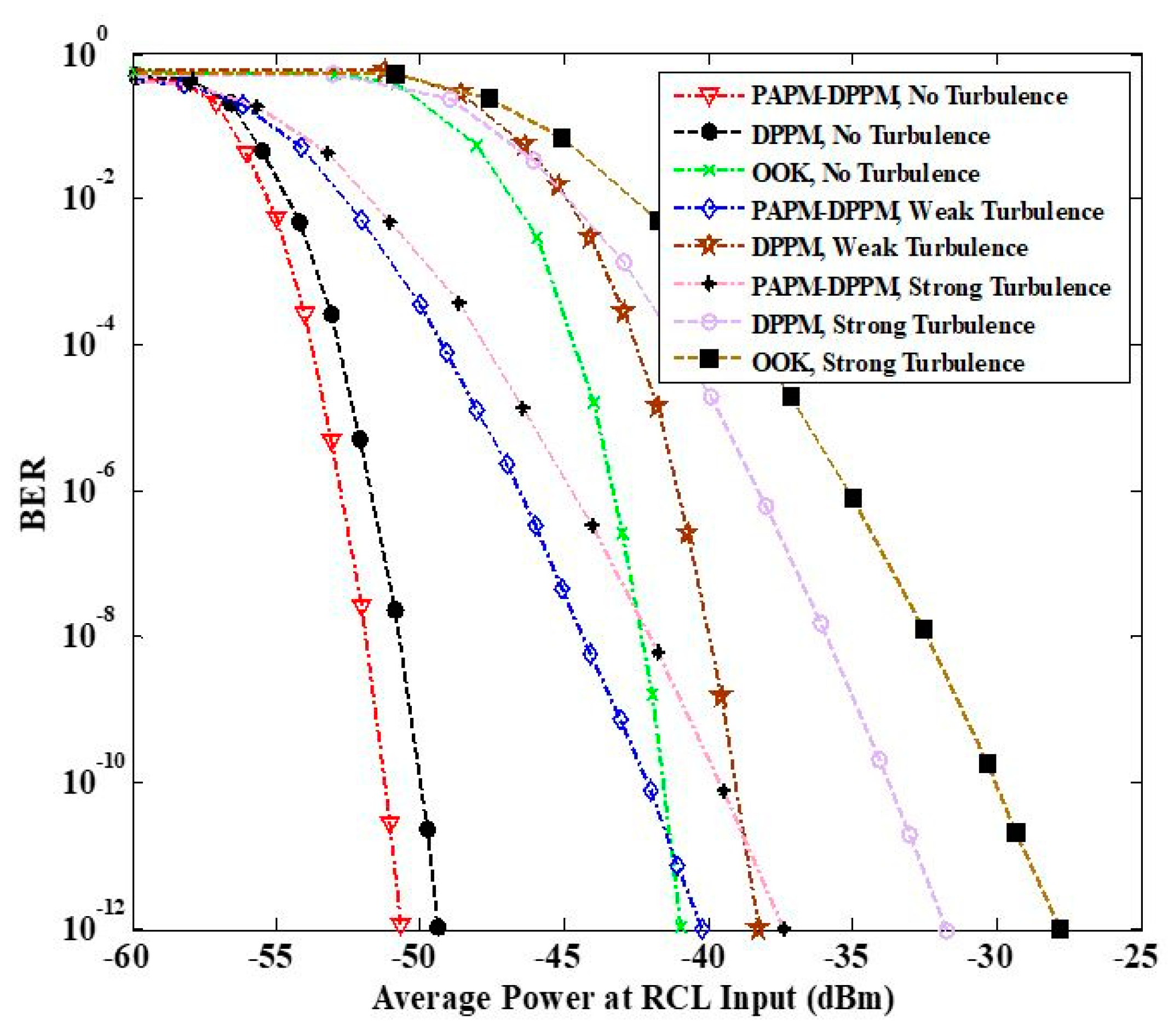
| Parameters | Description | Refs. [2,17] | Ref. [42] | [Proposed Work] |
|---|---|---|---|---|
| Data rate | 2.5 Gbps | 2.5 Gbps | 2.5 Gbps | |
| Demux OBPF bandwidth | 80 GHz | 76 GHz | 80 GHz | |
| Wavelength | 1550 nm | 1550 nm | 1550 nm | |
| η | Quantum efficiency | 0.75 | 0.9 | 1 |
| G | OA gain | 30.6 dB or 8.8 dB | 27 dB or 8 dB | 30 dB or 8 dB |
| NF | OA noise figure | 4.77 dB [2] | 4.77 dB [2] | 4.77 dB [2] |
| FSO link length | 1000 m and 1500 m | 1000 m and 1500 m | 1500 m and 4000 m | |
| ASE noise polarization states | 2 | 2 | 2 |
| Modulation Scheme | Bits per Symbol | Bandwidth Requirement | Spectral Efficiency |
|---|---|---|---|
| MPPM | |||
| M-ary-PAPM | |||
| Hybrid M-ary PAPM- |
| Ref. [2] | Ref. [5] | Ref. [8] | Ref. [9] | Ref. [15] | Ref. [42] | [Proposed Work] | |
|---|---|---|---|---|---|---|---|
| Technique used | DPPM-FSO link | WDM-FSO hybrid fiber-based DPPM | DPPM- based DWDM-FSO system | M-ary PPM-based WDM -FSO system | WDM-FSO network-based DPPM modulation | DPPM-based WDM-FSO communication system | hybrid M-ary-PAPM M-DPPM-based DWDM FSO optical fiber network |
| Data rate | 2.5 Gbps | 2.5 Gbps | 2.5 Gbps | 2.5 Gbps | 2.5 Gbps | 2.5 Gbps | 2.5 Gbps |
| Net capacity | 2.5 Gbit/s | 5 Gbit/s | 20 Gbit/s | 20 Gbit/s | 5 Gbit/s | 5 Gbit/s | 20 Gbit/s |
| Maximum link range reported | 1500 m | 2000 m | 4000 m | 2500 m | 2000 m | 2000 m | 4000 m |
| Quantum efficiency | 0.75 | 0.8 | 1 | 1 | 0.8 | 0.9 | 1 |
| No. of channels | 1 | 2 | 8 | 8 | 2 | 2 | 8 |
| Target BER |
| Ref. [50] | [Proposed Work] | |
|---|---|---|
| Modulation scheme technique | hybrid MPAPM technique deep space optical link | hybrid M-ary-PAPM M-DPPM-based DWDM FSO optical fiber network |
| OSNR improved | 1 dB and 2 dB | 4–8 dB |
| Target BER | ||
| Optical pulses per frame for M | 16 | 16 |
Publisher’s Note: MDPI stays neutral with regard to jurisdictional claims in published maps and institutional affiliations. |
© 2021 by the authors. Licensee MDPI, Basel, Switzerland. This article is an open access article distributed under the terms and conditions of the Creative Commons Attribution (CC BY) license (https://creativecommons.org/licenses/by/4.0/).
Share and Cite
Hayal, M.R.; Yousif, B.B.; Azim, M.A. Performance Enhancement of DWDM-FSO Optical Fiber Communication Systems Based on Hybrid Modulation Techniques under Atmospheric Turbulence Channel. Photonics 2021, 8, 464. https://doi.org/10.3390/photonics8110464
Hayal MR, Yousif BB, Azim MA. Performance Enhancement of DWDM-FSO Optical Fiber Communication Systems Based on Hybrid Modulation Techniques under Atmospheric Turbulence Channel. Photonics. 2021; 8(11):464. https://doi.org/10.3390/photonics8110464
Chicago/Turabian StyleHayal, Mohammed R., Bedir B. Yousif, and Mohamed A. Azim. 2021. "Performance Enhancement of DWDM-FSO Optical Fiber Communication Systems Based on Hybrid Modulation Techniques under Atmospheric Turbulence Channel" Photonics 8, no. 11: 464. https://doi.org/10.3390/photonics8110464
APA StyleHayal, M. R., Yousif, B. B., & Azim, M. A. (2021). Performance Enhancement of DWDM-FSO Optical Fiber Communication Systems Based on Hybrid Modulation Techniques under Atmospheric Turbulence Channel. Photonics, 8(11), 464. https://doi.org/10.3390/photonics8110464





